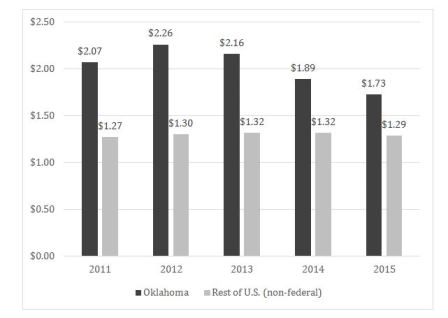For Immediate Release | October 5, 2017
WASHINGTON, D.C. – Total workers’ compensation benefits paid and costs to employers in Oklahoma declined sharply in recent years compared to the rest of the U.S., according to a new report from the National Academy of Social Insurance (the Academy).
In 2015, workers’ compensation benefits paid in Oklahoma were $732.5 million. Between 2011 and 2015, total benefits paid fell 12.8 percent, with the reduction occurring primarily between 2013 and 2015; benefits increased 0.3 percent from 2011 to 2013, but declined 13.0 percent from 2013 to 2015.
“Oklahoma implemented a number of significant changes to its workers’ compensation system in 2014 under Senate Bill 1062,” said Christopher McLaren, Senior Researcher at the Academy and lead author of the report. “The sharp declines experienced in total benefits paid and employer costs immediately after the bill was enacted suggest that it played a significant role in the trends occurring in Oklahoma.”
The decline in total benefits paid in Oklahoma was primarily driven by reductions in cash benefits paid. The percentage decrease in cash benefits was almost triple the percentage decrease in medical benefits (-17.6 percent vs. -6.7 percent). As a result, the share of medical benefits in Oklahoma increased from 44.4 percent of total benefits paid in 2011 to 47.5 percent in 2015. Among all states, Oklahoma had the 14th lowest percentage share of medical benefits relative to total benefits paid in 2015.
Oklahoma also experienced a significant decline in employer costs for workers’ compensation after the implementation of Senate Bill 1062. Between 2011 and 2013, costs in Oklahoma increased 15.2 percent, but between 2013 and 2015, costs fell 14.1 percent. Across the entire time period, costs in Oklahoma declined 1.0 percent, in sharp contrast to the 21.1 percent increase in costs that occurred in the rest of the U.S.
Table 1. Workers’ Compensation Benefits, Coverage, and Costs: Oklahoma and the Rest of the U.S. (non-federal)
|
2015 |
Percent Change 2011 to 2015 |
|||
|
OK |
Rest of U.S. |
OK |
Rest of U.S. |
|
| Aggregate Benefits, Coverage, and Costs | ||||
| Total Benefits (billions) |
$0.73 |
$57.4 |
-12.8% |
1.1% |
|
Medical Benefits |
$0.35 |
$29.6 |
-6.7% |
0.8% |
|
Cash Benefits |
$0.38 |
$27.9 |
-17.6% |
1.4% |
| Covered Workers (thousands) |
1,458 |
131,379 |
6.9% |
8.0% |
| Covered Payroll (billions) |
$63.6 |
$6,910 |
18.4% |
19.2% |
| Employer Costs (billions) |
$1.1 |
$88.8 |
-1.0% |
21.1% |
Workers’ compensation, the nation’s first social insurance program, pays medical benefits to the providers of health care for injured workers, and cash benefits to workers whose injuries prevent them from working. Much of the interstate variation in benefit payments and employer costs can be attributed to different trends in employment and wages across states, rather than to structural differences in state workers’ compensation systems.
Nevertheless, “the large decreases in total workers’ compensation benefits and costs in Oklahoma, relative to the rest of the U.S., do not appear to be explained by differential trends in employment and wages in Oklahoma,” said Marjorie Baldwin, Professor at Arizona State University and co-author of the report. “Between 2011 and 2015, workers’ compensation covered employment and wages in Oklahoma increased at rates close to the rates for the rest of the U.S.”
Other findings on workers’ compensation in Oklahoma from the Academy’s report include:
- Growth in covered employment and payroll in Oklahoma was slightly below the growth rate in the rest of the nation. In 2015, covered employment reached 1.5 million in Oklahoma, up 6.9 percent from 2011 (8.0 percent for the rest of the nation), and covered payroll was $63.6 billion, up 18.4 percent from 2011 (19.2 percent for the rest of the nation).
- Between 2011 and 2015, benefits as a share of payroll in Oklahoma declined from $1.56 to $1.15 – the second largest decline in the country in that time period (Figure 1). Benefits as a share of payroll declined in the rest of the U.S., but at a much more gradual pace.
Figure 1. Workers’ Compensation Benefits per $100 of Covered Payrolls, 2011-2015: Oklahoma and the Rest of the U.S. (non-federal)

- Employer costs in Oklahoma declined to $1.73 per $100 of covered payroll in 2015 (Figure 2). Between 2011 and 2015, Oklahoma experienced the third largest decline in costs as a share of payroll, with the large reduction occurring between 2013 and 2015. Costs as a share of payroll remained virtually unchanged in the rest of the U.S. in the same period.
Figure 2. Workers’ Compensation Costs per $100 of Covered Payroll, 2011-2015: Oklahoma and the Rest of the U.S. (non-federal)

Workers’ Compensation: Benefits, Coverage, and Costs (2015 data) is the 20th in an annual series. The report provides the only comprehensive data on workers’ compensation benefits, coverage, and employer costs for the nation, the states, the District of Columbia, and federal programs.
EXPERTS TO CONTACT:
| Christopher McLaren
National Academy of Social Insurance |
Marjorie Baldwin
Arizona State University (480) 965-7868
|
The National Academy of Social Insurance is a non-profit, nonpartisan organization made up of the nation’s leading experts on social insurance. Its mission is to advance solutions to challenges facing the nation by increasing public understanding of how social insurance contributes to economic security.
See related news: Disability, Workers' Compensation, Workforce Issues and Employee Benefits
